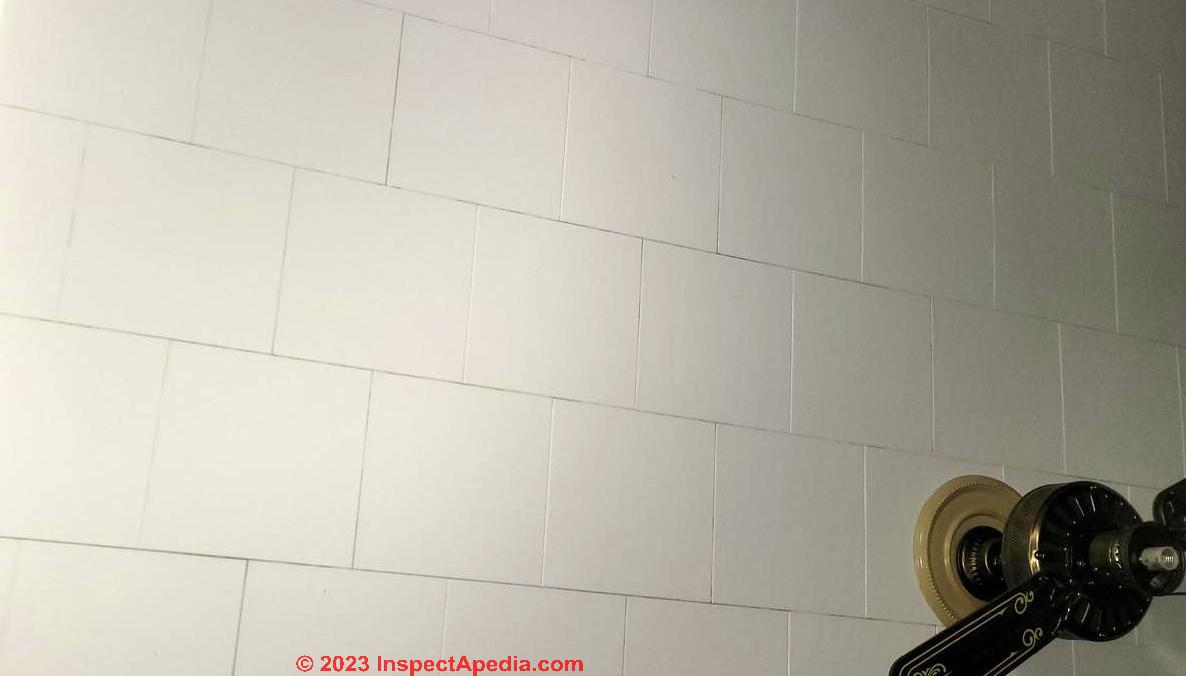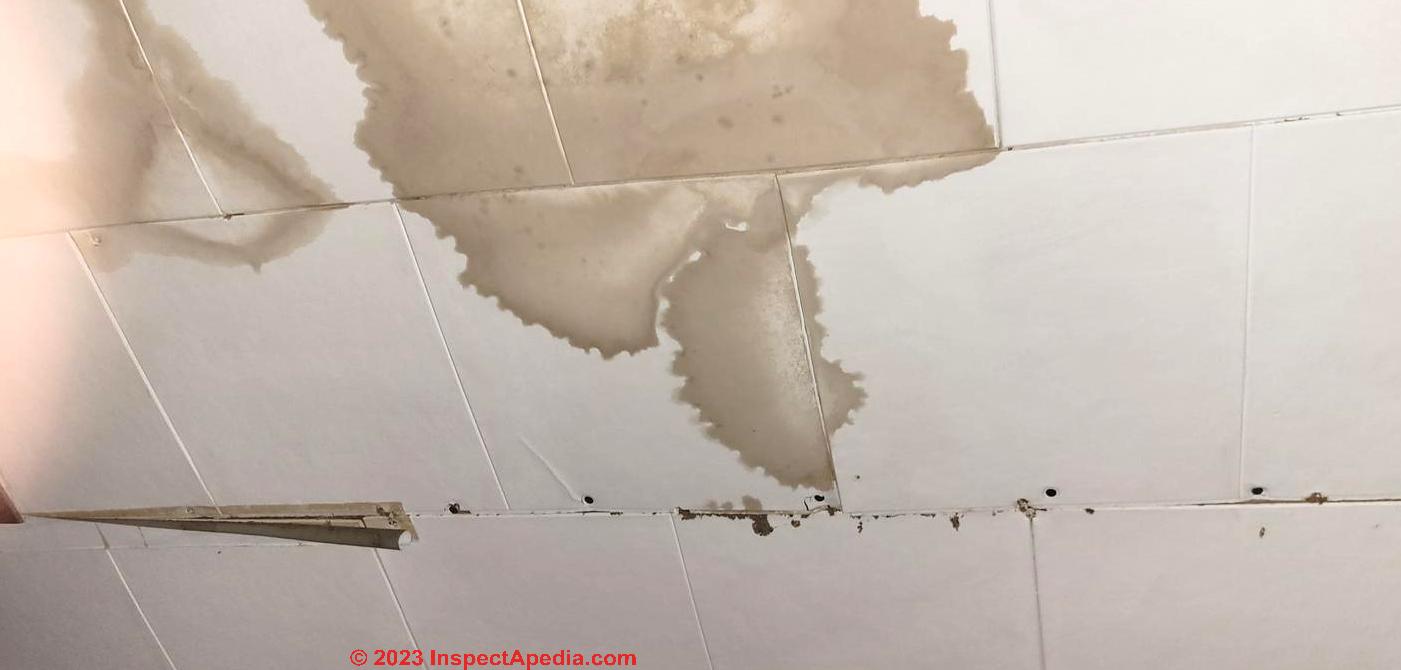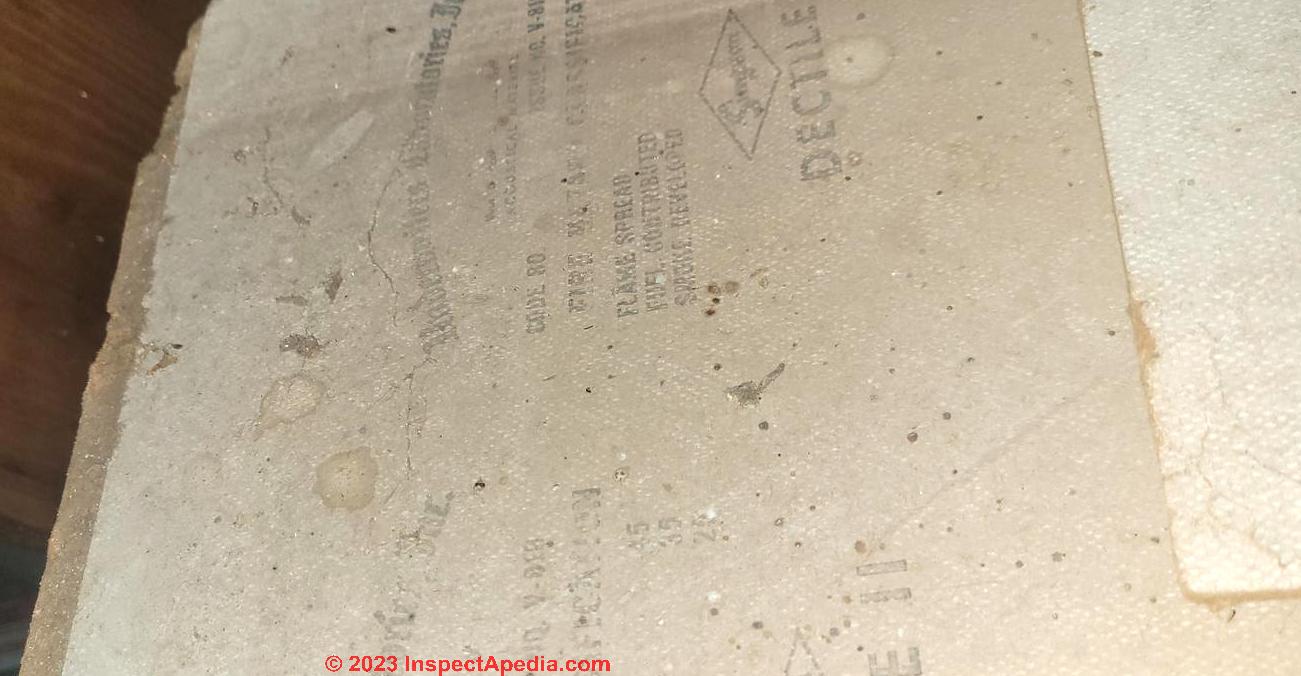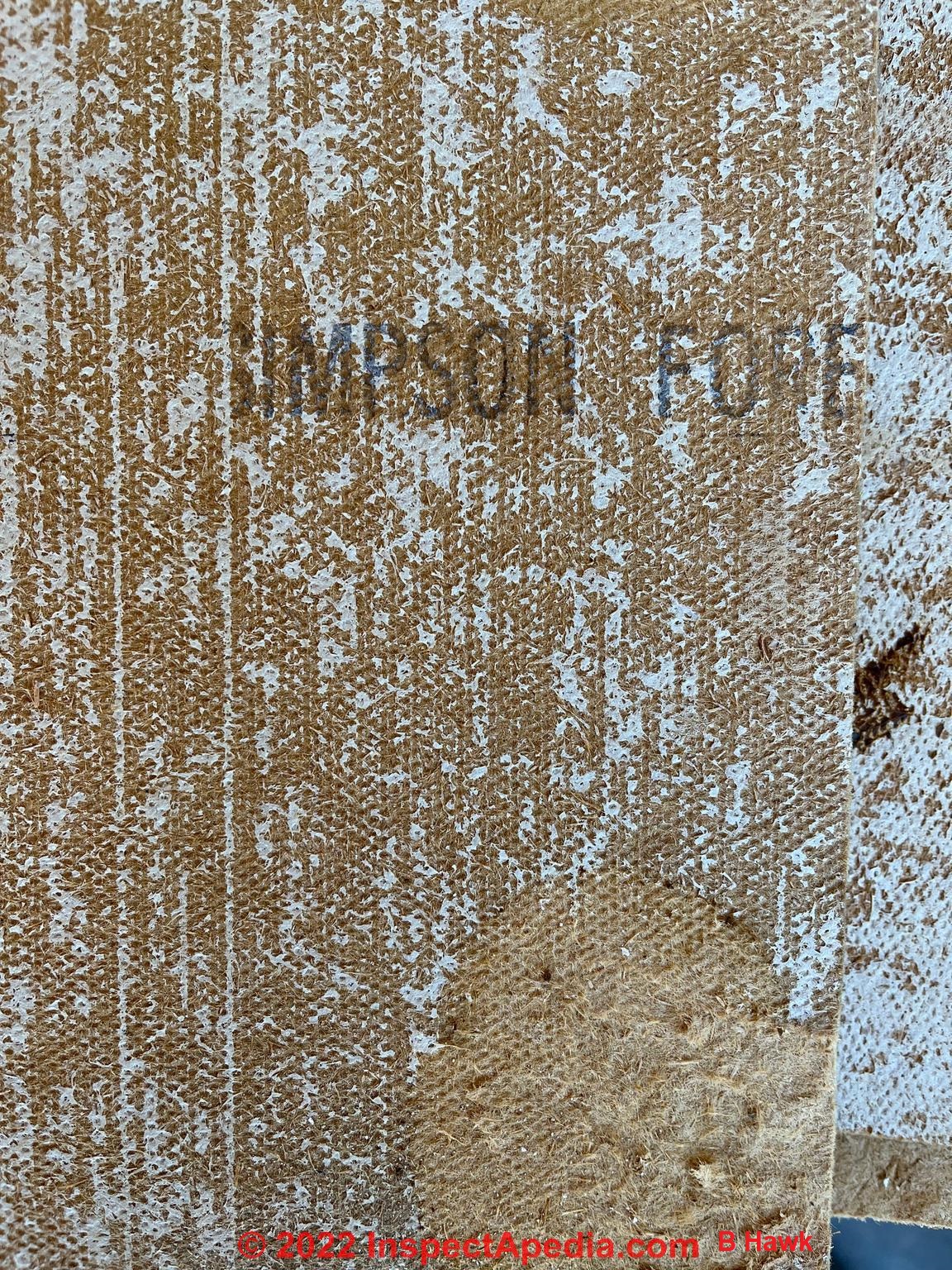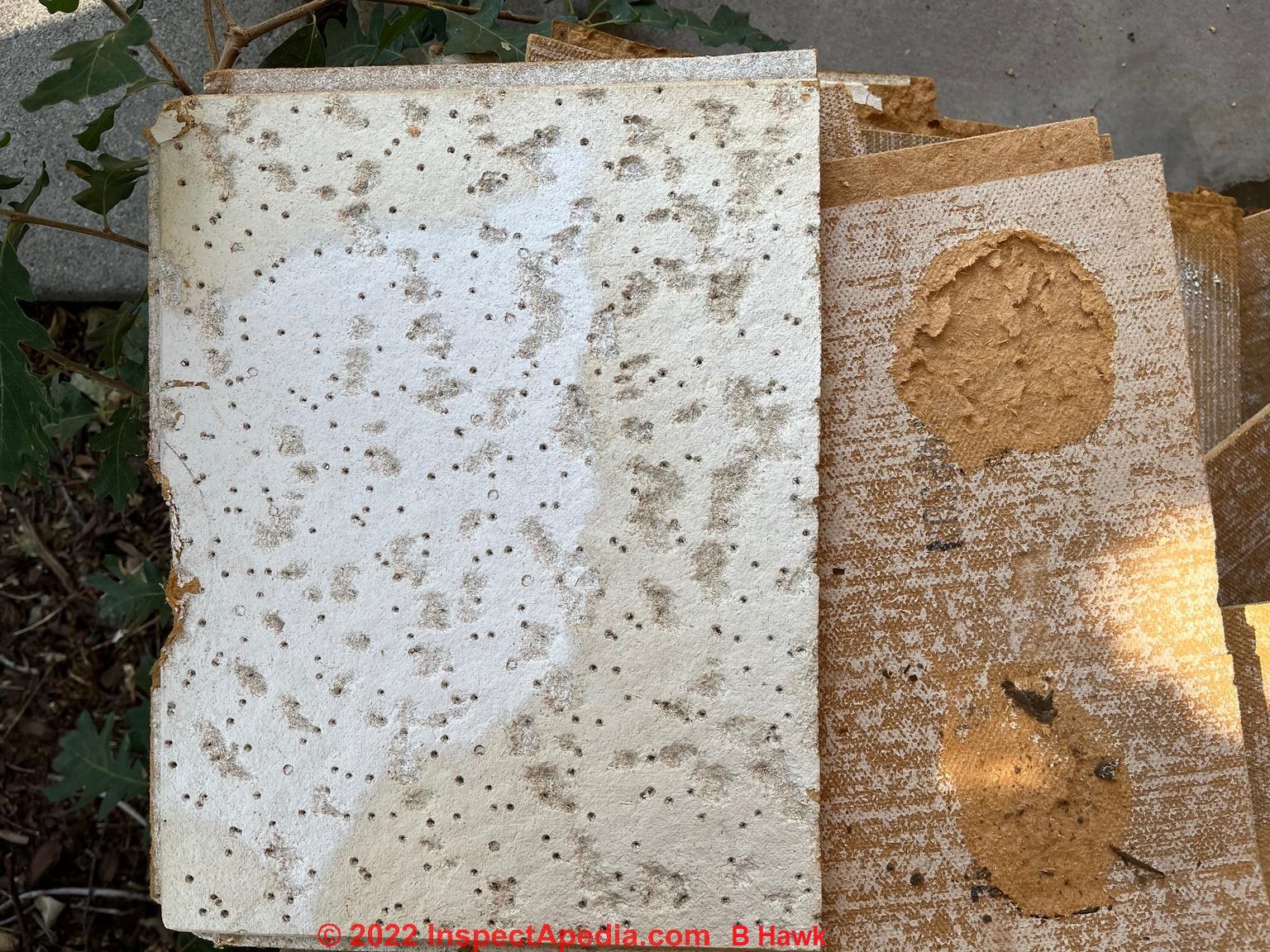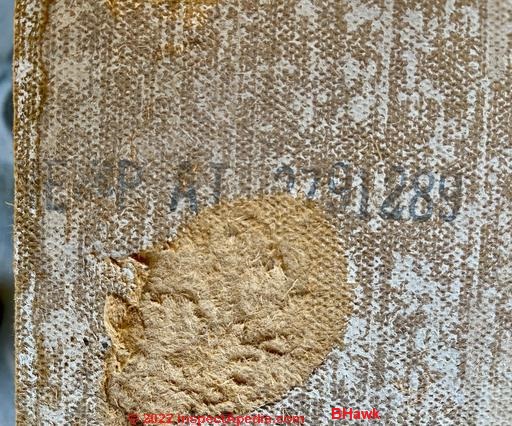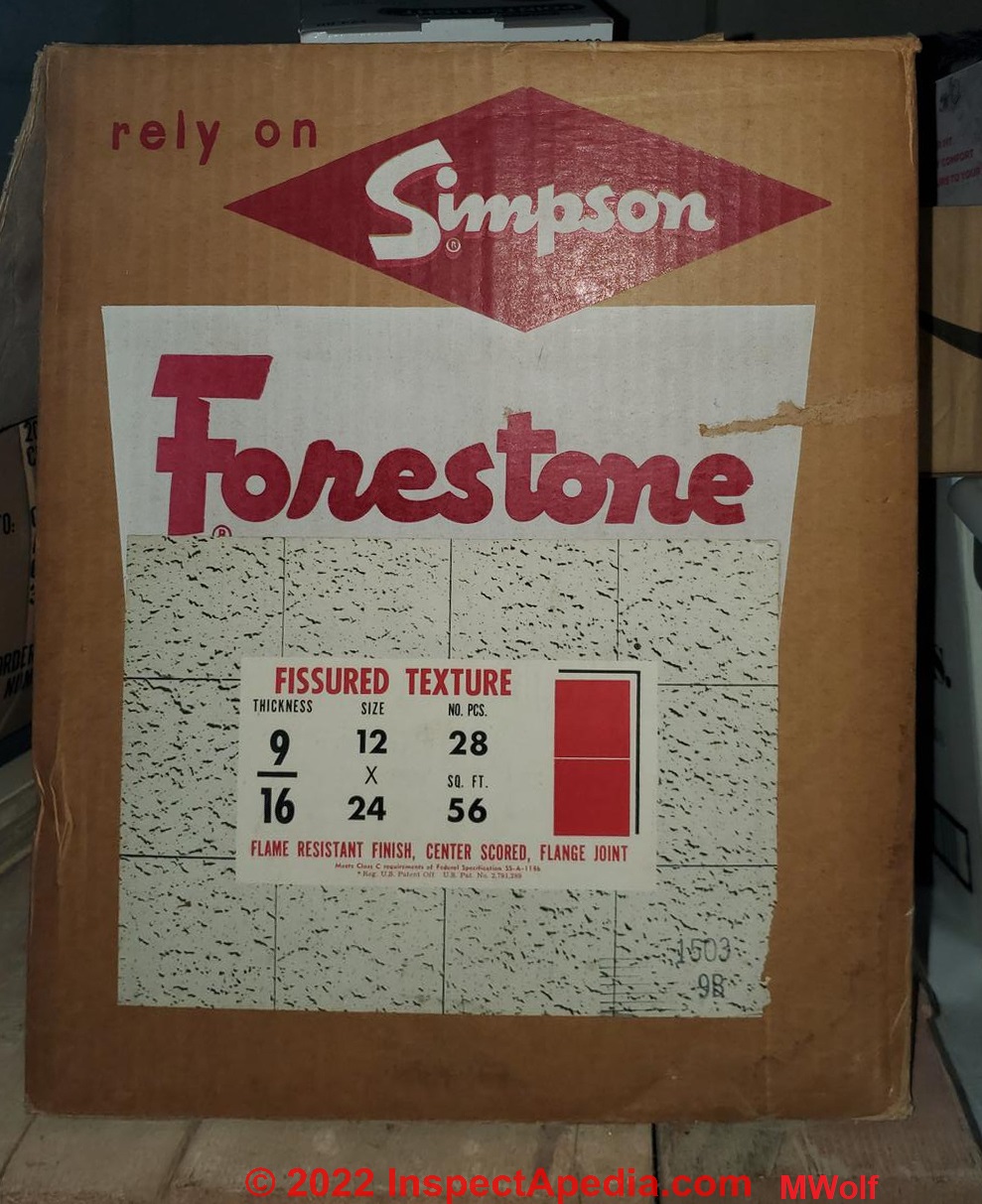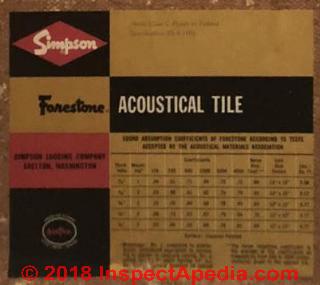 Asbestos in Simpson Ceiling Tiles
Asbestos in Simpson Ceiling Tiles
Asbestos in Simpson Forestone ceiling tiles vs
Simpson Pyrotec & Other Simpson acoustic ceiling tiles
- POST a QUESTION or COMMENT about how to identify ceiling tiles that contain asbestos
Some Simpson brand ceiling tiles may contain asbestos:
The company said that their product did not contain asbestos. Litigation raised the asbestos question nevertheless.
In this article series we discuss how to recognize & handle ceiling tiles that may contain asbestos.
We describe the appearance, ingredients, years of manufacture, history, and producers of various types of ceiling tiles & coverings as an aid in determining whether or not a particular ceiling covering or tile is likely to contain asbestos.
InspectAPedia tolerates no conflicts of interest. We have no relationship with advertisers, products, or services discussed at this website.
- Daniel Friedman, Publisher/Editor/Author - See WHO ARE WE?
Simpson Forestone Woodfiber Acoustic Ceiling Tiles - no asbestos according to Simpson, Maybe asbestos according to lawsuit
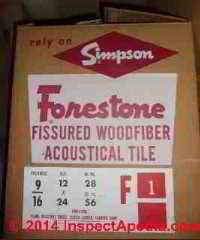 From multiple sources cited here we know that at most (about 3/4 of all) Simpson ceiling tiles contained asbestos.
From multiple sources cited here we know that at most (about 3/4 of all) Simpson ceiling tiles contained asbestos.
Watch out: Troyce Wolf, a lead attorney for the defendants (Conwed and Simpson) in the Wagner mesothelioma lawsuit discussed in this article pointed out that
... Conwed and Simpson offered both asbestos-containing and non-asbestos-containing product lines. The tiles – one hazardous and one not – looked virtually identical.
“The two types of ceiling tiles were visually impossible to tell apart,” explained Troyce Wolf.
The attorneys for the plaintiffs (Wagner's survivors) searched product catalogs from both Simpson and Conwed, finding that roughly 75% of those ceiling tiles were Conwed's Lo-Tone asbestos-containing tiles. Conwed asbestos ceiling tiles were also purchased and re-sold by Simpson.
For these reasons it would be prudent to either treat any Simpson or Conwed ceiling tiles from the 1960s as PACM (Presumed Asbestos Containing Material) unless or until you have representative samples of such ceiling tiles tested by a certified asbestos test lab.
At the end of this article we include a link to a directory of certified asbestos labs.
Watch out: The Wood Conversion Company who produced Nu-Wood products later became Conwed Corporation. Court documents assert that some Conwed ceiling tiles contained asbestos. - (Wagner v. Bondex, Simpson, & Conwed, 2012)
Also see NU-WOOD STA-Lite CEILING TILES
Reader question:
I have a basement finished with acoustical ceiling tile. The previous owners left two boxes of the material. I took a picture of the box, but don't see how to post it. The box is printed with the following: Simpson Forestone Fissured Woodfiber Acoustical tile.
A large label is glued to the box with the following: Thickness: 9/16. Size 12 x 24. No PCS. Sq FT 56.
Large red F with a 1 in white in a reverse print. Then it says, Forestone Flame Resistant Finish. Center scored, flanged joint. Meets Class C of the requirements of Federal specification SS-A-118b. It also has a hand stamp that looks like a lot number of 30182.
Can you tell me if it contains asbestos? The Simpson lumber company is still in business. Would they know?
re-posting a subsequent post: Michael said:
Here is the photo of the Simpson Forestone acoustical tile packaging [photo above left].
[re-published; reader-links get blocked for malware security but I took a snapshot of your photo for use as needed here - Ed.] 4/15/14 Michael
Reply:
Let's try this: take another look at the box and give me
- any dates or date stamp codes on the material. If the lot number can be translated to mean made in 1982 that ought to be far enough past the use of asbestos in ceiling tile products as well as flooring to answer the asbestos question for this product -
The company can translate the lot number for you. (Let me know) The product label refers to wood products as the ingredients. We don't yet know where the flame resistance derives.
- the U.S. Patent number at the bottom of the label (I couldn't read it in your photo)
and we'll research the tile further.
Reader follow-up:
Michael said:
The only thing stamped on the material itself is the patent number: 2,791,289. The patent (from 1952) covers how they create the textured look. The patent does mention a bunch of materials, but not asbestos. ...
I emailed Simpson's Public Affairs (its the only email contact on their website) and they responded that Forestone does not have any asbestos in it.
Reply:
Helpful Michael, I'll add photos and information to our article as it should help others. Generally when a product says it's made from wood fibers it's not an asbestos item. That patent number is helpful - that's what I wanted to see.
Some photos of the surfaces of the tiles themselves would be helpful if that's convenient. You can use our email address at CONTACT found at page bottom.
Nice going.
However take care to read the information below about some Simpson ceiling tiles containing asbestos.
. - DF
Question: does this Simpson ceiling tile contain asbestos?
We wanted to replace the old ceiling tiles with drywall & ripped a couple down to see what we were working with.. the home was built in 1947. Any idea a date for these or if they contain asbestos?
See the reader's Simpson Acoustical Tile Fonestone brand photos just above and just below. 2018/06/18 katie.nussbaum16
Reply: possibly some Simpson / Conwed ceiling tiles contained asbestos, per according to Wagner v. Conwed & Simpson in 2009
Katie
Please see SIMPSON CEILING TILES just above
We will add your photo to invite further comment. There a reader reports that Simpson (your ceiling tile is a Simpson Fonestone) informed him that their Fonestone line of ceiling tiles does not contain asbestos.
Let us know if you have further questions.
Watch out: at least some production associated with the Simpson brand has been found to involve asbestos. In June 2009 in the U.S. a Clayton County Missouri court, by jury trial, awarded damages to the family of a construction worker who died from mesothelioma after having worked for companies' asbestos-containing products thirty years previously.
Robert Wagner's death was considered to be the direct result of "... legal exposure to the asbestos contained in products manufactured and distributed by Conwed Corp., Simpson Timber Co., and Bondex International in the 1960s and 1970s
,...Mr. Wagner’s co-workers testified that he installed thousands upon thousands of ceiling tiles during his long career tenure. They confirmed never having seen a warning on product packaging about the asbestos hazard, and none wore maskes or breathing apparatus.
Product identification was central to the case. At the time of Mr. Wagner’s employment, Conwed and Simpson offered both asbestos-containing and non-asbestos-containing product lines. The tiles – one hazardous and one not – looked virtually identical.
“The two types of ceiling tiles were visually impossible to tell apart,” explained Troyce Wolf, WK partner and lead trial attorney. - retrieved 2018/06/17, original sources include: https://law.justia.com/cases/missouri/court-of-appeals/2012/wd72474.html and waterskrauspaul, a plaintiff's litigation law firm, https://www.waterskraus.com/ceiling-tile-installer-awarded-4-5m-in-asbestos-exposure-case/
Really? Because the attorneys in the case took what was described as a "shotgun approach" there were multiple defendants in this case and multiple products that contained or may have contained asbestos, fogging the view of the specific question about asbestos in Simpson/Conwed ceiling tiles.
Because Wagner worked around and used so many materials that contained asbestos, the plaintiffs relied on extensive witness testimony from Wagner's colleagues concerning which materials were used in the sites where he worked.
Some defendants confidentially settled with the plaintiffs before trial, some claims were dismissed and other defendants won on summary judgment.
Defendants included Bondex (joint compound containing asbestos), Conwed Corp. & Simpson Timber Co. (ceiling tile producers), and other defendants not identified in the press releases.
- Citation of case law: LOIS J. WAGNER, ROBIN G. WAGNER AND WENDE L. WAGNER, Individually and as Wrongful Death Beneficiaries of Robert Wagner vs. Bondex International Inc., and Simpson Timber Company Conwed Corporation, Defendant [PDF] - First Four Pages [PDF] Date: June 19, 2012 Docket Numbers: WD72474, WD72482, WD72619, retrieved 2018/06/17, original source: https://law.justia.com/cases/missouri/court-of-appeals/2012/wd72474.html
- Waters & Kraus, CEILING TILE INSTALLER AWARDED $4.5M IN ASBESTOS-EXPOSURE CASE [PDF], Waters & Kraus was the plaintiff's attorney in the Wagner case cited above, WatersKrausPaul, Esq., 3141 Hood Street,
Suite 700,
Dallas, Texas 75219
Toll Free: 866.305.7373 Phone: 214.357.6244, case description retrieved 2018/11/09, original source: https://www.waterskraus.com/ceiling-tile-installer-awarded-4-5m-in-asbestos-exposure-case/ - Asbestos in Joint Compound, Bondex:
[Note that asbestos was commonly used in other brands of joint compound as well.]
Bondex manufactured a joint compound that was commonly used on construction sites during the installation of drywall. From 1961 to 1977, Bondex joint compound contained asbestos. -
retrieved 15 June 2015 original source: www.courts.mo.gov/file.jsp?id=54841 [LOIS J. WAGNER, ROBIN G. ) WAGNER and WENDE L. WAGNER, ) Individually and as Wrongful Death ) Beneficiaries of ROBERT WAGNER, ) ) Appellant-Respondent, ) ) WD72474 (Consolidated with WD72482 v. ) and WD72619) ) BONDEX INTERNATIONAL, INC., and ) Opinion filed: June 19, 2012 SIMPSON TIMBER COMPANY, ) ) Respondent-Appellant, ) ) CONWED CORPORATION, ) ) Defendant. ) APPEAL FROM THE CIRCUIT COURT OF CLAY COUNTY, MISSOURI The Honorable Kathryn E. Davis, Judge Before Division Four: Lisa White Hardwick, Chief Judge, Presiding, Joseph M. Ellis, Judge and Victor C. Howard, Judge]
Question: Simpson Timber Co. of Seattle "Dectile Class III Vinyl coated decorative tiles
(June 15, 2015) Ron W. said:
My mom just passed away and her house has the Simpson Timber Co. of Seattle "Dectile Class III Vinyl coated decorative tiles" in it. We are selling the house and a potential buyer asked about the possibility of them containing asbestos. Do you know if this particular type did?
Reply:
Ron I don't know much about the Simpson Timber brand of ceiling tiles though from a timber company you'd think the product would be made from wood fibers.
However litigation that we discuss beginning at SIMPSON CEILING TILES indicates that some Simpson products contained asbestos, while the company has indicated to one of our readers that Simpson Fonestone ceiling tiles did not contain asbestos.
Cited in this court proceeding: www.courts.mo.gov/file.jsp?id=54841 - this is a wrongful death lawsuit involving Robert Wagner who in 2006 was diagnosed with mesothelioma. Excerpting:
In 2006, Robert Wagner was diagnosed with mesothelioma, a cancer that affects the pleural lining of the lungs. During the 1960s and 1970s, Wagner worked as a carpenter installing ceiling tile at project sites in the Kansas City area. Wagner worked primarily for two companies during that time period, Kansas City Natural Slate and United Acoustics.
In 2007, Wagner died from mesothelioma, and his wife and children ("Plaintiffs") brought this wrongful death action. Plaintiffs claimed that Wagner's mesothelioma resulted from exposure to the asbestos-containing products manufactured by Bondex and Simpson Timber ("Defendants").
Bondex manufactured a joint compound that was commonly used on construction sites during the installation of drywall. From 1961 to 1977, Bondex joint compound contained asbestos.
Simpson Timber manufactured ceiling tiles. During the 1960s, Simpson Timber manufactured both asbestos-containing ceiling tile and non-asbestos-containing ceiling tile. Simpson Timber also purchased and resold ceiling tile from Conwed that contained asbestos.
On June 3 2009, the jury returned a verdict in favor of Plaintiffs in the amount of $4.5 million. The jury apportioned fault as follows: 20% to Bondex, 35% to Simpson Timber, and 45% to Conwed Corporation. Following the verdict each defendant filed a motion to delay entry of the judgment.
On July 7 2009 the trial court entered its Judgement and Order reducing the judgement amounts. Defendants then filed motions for judgement notwithstanding the verdict "JNOV". All JNOV motions were denied.
Following the trial court judgement the defendant appealed the judgement to the Court of Appeals of Missouri, Western District, Division Four.
The appeal was dismissed because the trial court did not address the remaining John Doe defendants named in the suit.
Plaintiffs also filed a motion to dismiss and for entry of an amended judgment arguing that the settlement process between Plaintiffs and the THAN Bankruptcy Trust was deemed non-existent by a federal bankruptcy court.
On 24 May 2010 the trial court entered its final judgment that reduced the settlement amounts by $1,425,000.
Both Defendants (Bondex and Simpson Timber) and Plaintiffs appealed that judgment. (Defendants claimed that plaintiffs failed to demonstrate causation.) A key point of law argued in the 2012 appeals court ruling was from Poloski, "IN order to prove causation a plaintiff must prove that 'but for' the breach of duty, the event would not have occurred. (Supported also in Calahan).
In June 2012, the appeals court case of Wagner v. Bondex and Simpson Timber and Conwwed Corporation was decided, affirming the lower court's judgment.
Also see "Research: Asbestos found in Nu-Wood, Wood Conversion Company, Bondex, Simpson Timber products"
at SHEATHING, FIBERBOARD ASBESTOS CONTENT
It is important for both you and a buyer to avoid inappropriate (and thus expensive) panic about asbestos. Generally asbestos-containing materials such as ceiling tiles are safest left alone and in-place unless the material is damaged, falling down, shedding, leaving debris that can be tracked through a home or otherwise made airborne.
It's ok to paint over, encapsulate, seal, or cover-over such materials if occupants prefer. Unnecessary removal is actually more likely to be hazardous than leaving the material alone.
Was there Asbestos in 1960s Simpson Pyrotect Ceiling Tiles?
Wondering if you have any info on
UnderwritersLlaboratories Inc UL-
Listed
Acoustical material
Code 85 issue no. Af-646
Simpson Pyrotect
[Click to enlarge any image] - shown above, back imprint information on Simpson Pyrotect ceiling tiles. At page top: Simpson Forestone ceiling tiles.
This Q&A were posted originally
at ASBESTOS CEILING TILE FAQs-3
On 2019-02-20 by (mod) - asbestos content in Simpson Pyrotect& History of Simpson Timber & Lumber Co. Ceiling Tiles
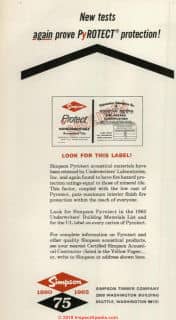 The advertisement for Simpson PyROTECT ceiling tiles shown here appeared in the 1965 issue of the AIA Journal, June 1965 Official Convention Guide, p. 30. Retrieved 2019/02/20 original source: http://www.usmodernist.org/AJ/AJ-1965-06.pdf
The advertisement for Simpson PyROTECT ceiling tiles shown here appeared in the 1965 issue of the AIA Journal, June 1965 Official Convention Guide, p. 30. Retrieved 2019/02/20 original source: http://www.usmodernist.org/AJ/AJ-1965-06.pdf
Excerpt: Simpson Pyrotect acoustical materials have
been retested by Underwriters' Laboratories,
Inc. and again found to have fire hazard protection ratings equal to those of mineral tile.
This factor, coupled with the low cost of
Pyrotect, puts maximum interior finish fire
protection within the reach of everyone.
Look for Simpson Pyrotect in the 1965
Underwriters' Building Materials List and
for the UL label on every carton of Pyrotect.
The Simpson Pyrotect ceiling tile shown in your photo above, produced by the Simpson Timber Company (founded 1890) was described in Oregon State University's index of Forest Industry Products in 1963 in this article:
- Simpson Used Gimmick to Dramatize Pyrotect Tile (Fl) July 63:112 - [copy on file as Forest-Industry-Journal-1963.pdf] W.I. West (ed), Oregon State University, retrieved 2019/02/20, original source: https://ir.library.oregonstate.edu/downloads/zg64tm03s
giving us an era-date of the early 1960's for the product - consistent with the trademark filing.
The actual article on Simpson's Pyrotcect tile is not (yet) found online - that'd be a perfect place to confirm the presence or absence of asbestos in the product description as may be some patent disclosures.
According to the trademark filing, this was a wood product - asbestos isn't cited nor were the fire resistive properties explained: I am researching further.
PYROTECT - Owned by: SIMPSON TIMBER 2000 Washington Building, Seattle, Washington 98101 ... Filed on: 12-06-1962 Status: Expired
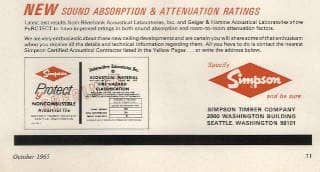 A detailed history of the Simpson Timber Co. is given by
A detailed history of the Simpson Timber Co. is given by
- SIMPSON TIMBER COMPANY, 5 Generations of Family Management, a monograph by Leitzinger, Joseph L. (1999), No. 22 in a series of monographs on the history of plywood, published by Plywood Pioneers Association / Forest History Society, Durham NC, retrieved 2019/02/20, original source:
Simpson Timber Co / Simpson Lumber Co. was purchased by Tacoma Tideflats, a Canadian forest products company early in 2015
Also see
- PERFORMANCE DATA of ARCHITECTURAL ACOUSTICAL MATERIALS [PDF], (1966) Acoustical Materials Association Performance Acoustical Materials Performance Data Bulletin No. XXVI, Acoustical Materials Association, 335 E. 45TH St., New York, N. Y. 10017 USA retrieved 2019/02/20 original source: https://ia800602.us.archive.org/22/items/TNM_Acoustical_Materials_Association_Performance_Acoustical_Materials_Performance_Data_1966_XXVI/TNM_Acoustical _Materials_Association_Performance_Acoustical_Materials_Performance_Data_1966_XXVI.pdf
Really? It's helpful to note that fire resistance in ceiling tiles and ceiling panels was achieved in some products without use of asbestos, such as use of gypsum board panels and use of mineral fibers or slag wool or mineral wool or fiberglass.
Watch out: however as you will note in Simpson's patent below, the use of fiberglass did not rule out combination with asbestos.
- Simpson, Donald C. "Combined asbestos and glass fiber yarn." U.S. Patent 2,132,702, issued October 11, 1938.
Excerpts:
Another object of the invention is to utilize the softness, pliability and yieldability more naturally inherent in the asbestos fibers in combinationwith glass fibers, which are much stronger and longer than the asbestos fibers.
The individual glass fibers are sufilciently fine and long so that they may be intertwisted or interfelted with the asbestos fibers to form strong yarns which may be safely subjected to the rigors of a conventional loom.
The asbestos fibers serve as cushions for the adjacent glass fibers to assist in the distribution of loads throughout the glass fibers, and to lend yieldability and pliability and strength to the final fabric.
In addition, if the glass fibers have been intertwisted or interfelted with the asbestos fibers, this arrangement will prevent the individual glass fibers from being laid out in straight lines, but, on the contrary, will permit them to assume helithe fact that the asbestos material may be comparatively rough, and when composed of a mass more equally. - Proudfoot, Don A., Donald K Meissner, Arthur T Walton, PROCESS OF FORMING FISSURED FEBER ACOUSTCAL TELE AND PRODUCT THEREOF U.S. Patent 2791289 [PDF] Issued May 7, 1957, Assigned to Simpson Timber Co
(Application was filed 1952-12-10)
Excerpts:
More particularly this invention relates to the method of producing acoustical tile and the product thereof formed from fiber tile board having a front surface lying substantially in a common plane and wherein the end product has therein various size openings, including fissures, disposed in a random pattern in the surface of the tile to be exposed or in other words the front surface of the tile.
A variety of base materials and processes may be used to form the blank tile to be processed in accordance with this invention. The blank tiles to be processed in this invention may be of suitable surface area and suitable depth such as 12 inches by 12 inches and of an inch thick.
If such blank tiles are to be made of lignocellulose materials, the lignocellulose materials to be employed broady include annual products such as corn stalks, straw, sugar cane, etc. as well as wood from various species of trees, both hard and soft, as the source of the lignocellulose fiber to be processed to form blank tiles with a front surface face lying substantially in a common plane.
Also glass fiber may be employed as well as mineral wool as the source of the fiber to produce an acoustical tile blank.
Thus the tile blank may be formed of various fibers and may include most standard blank acoustical or imperforate tiles now on the market.
...
Reader Comments, Questions & Answers About The Article Above
Below you will find questions and answers previously posted on this page at its page bottom reader comment box.
Reader Q&A - also see RECOMMENDED ARTICLES & FAQs
Asbestos in 1960's Simpson ductile II Ceiling Tiles?
I purchased a home built in 1964? And have Simpson ductile II in it , asbestos in them or not?.
- On 2023-02-18 by Dave Simmonds
Reply by InspectApedia Editor - Simpson ductile II ceiling tiles
@Dave Simmonds,
Simpson said their ceiling tiles did not contain asbestos but litigation came up with a different answer as we describe above on this page.
For these reasons it would be prudent to either treat any Simpson ceiling tiles from the 1960s as PACM (Presumed Asbestos Containing Material) unless or until you have representative samples of such ceiling tiles tested by a certified asbestos test lab.
Generally asbestos-containing materials such as ceiling tiles are safest left alone and in-place unless the material is damaged, falling down, shedding, leaving debris that can be tracked through a home or otherwise made airborne.
It's ok to paint over, encapsulate, seal, or cover-over such materials if you prefer. Unnecessary removal is actually more likely to be hazardous than leaving the material alone.
In the list of Recommended Articles above, there is a live link for
DO THESE CEILING TILES CONTAIN ASBESTOS? - 5 Easy Steps to tell if CEILING TILES are likely to contain asbestos
Do take a look.On 2023-02-18 by Dave Simmonds
Thank you for your response. I have some that are damaged in the bathroom and hallway from a large leak. I'm going to push them back up and cover with 1/4 drywall.
On 2023-02-18 by InspectApedia Editor - damaged and sagging ceiling tiles need inspection to determine leak source
@Dave Simmonds,
Perfectly acceptable resolution IF you have made sure to address the leak that caused them to fall. Did you find the source of the leak, fix it, and also be sure that all wet materials were dry or replaced - drywall, insulation, wood?
The last thing you want to do is to enclose the space where the leak occurred without addressing its cause and fixing any damage. That would just be a potential breeding ground for mold let alone another leak.On 2023-02-18 by Dave Simmonds
This house has been empty for quite a while. A bearing on the whirlybird had failed and a storm took all but the metal tubing. Installed a new one. Everything is dry.
On 2023-02-18 by Mak Church (mod)
@Dave Simmonds,
Good to hear. Feel free to post photos of the sagging tiles and from the repair project as that can help other readers, too.
Possible asbestos in leak-damaged ceiling tiles
Before I even thought about the possibility of asbestos in the tile my son who's tall enough to reach the ceiling, pushed them up and screwed them up.
I guess you can call it luck, this was over the bathtub, so all the blown in insulation and any water ended up there.
- On 2023-02-18 by Dave Simmonds
Reply by InspectApedia Editor
@Dave Simmonds,
Thank you for these photos. A large leak to be sure.Follow-up by Dave Simmonds
I found a tile out with a bunch of door/window trim from someone attempt at "remodeling " , thought it might be useful for reference/ information.
Reply by Mak Church (mod)
@Dave Simmonds,
Yes, thank you for this photo as well. We do appreciate these types of reference photos.
Stopped removing 1959 Simpson Forestone ceiling tiles - Asbestos risk
Home was built in 1959. Simpson Forestone ceiling tiles were placed on the basement ceiling. Upon removal, the patent no. was noted to be 2,791,289. We have stopped removal process and are now covering the frayed, moldy tiles with drywall and paint.
- On 2022-07-31 by bhawk
On 2022-07-31 by InspectApedia-911 (mod) - 1959 Simpson Forestone ceiling tiles
@bhawk,
Take a look at
PROCESS OF FORMING FISSURED FEBER ACOUSTCAL TELE AND PRODUCT THEREOF U.S. Patent 2791289 [PDF] Issued May 7, 1957, Assigned to Simpson Timber Co
https://inspectapedia.com/hazmat/Proudfoot-Patent-US2791289
describing " lignocellulose fiber acoustical tile and glass fiber acoustical tile "
(For what it's worth, the word "asbestos" is not mentioned in the patent disclosure.)
Simpson Forestone ceiling tile.
On 2022-07-31 by bhawk
Classic "Fissured Texture".
Simpson Forestone
Do Simpson Fonestone ceiling tiles contain asbestos ?
I have this box of tiles in my crawlspace that my basement has installed in ceiling. Here is a picture of the box itself.
I would rather not mess with tiles but if we have to change a bulb in the future how would I do so to minimize disruption? I am curious if I can get information on asbestos just from this picture?
On 2020-03-06 by Mwolf -
On 2020-03-06 by danjoefriedman (mod)
MW
In the article above in answer to the question: Do Simpson Fonestone ceiling tiles contain asbestos, we include this key remark excerpted from litigation on the topic:
Product identification was central to the case. At the time of Mr. Wagner’s employment, Conwed and Simpson offered both asbestos-containing and non-asbestos-containing product lines. The tiles – one hazardous and one not – looked virtually identical.
However, for a box of intact ceiling tiles, even if these are ones that contain asbestos, the airborne asbestos hazard that you might face by having to move the box of Simpson Fonestone tiles (that may contain asbestos) is almost certainly below the limits of detection. Just open a plastic garbage bag, set the box inside, close the bag and put it with your trash.On 2022-07-31 by InspectApedia-911 (mod)
@bhawk,
You may want to remove the sprayed, moldy tiles so as not to leave a mold reservoir in the building.
I didn't find indications that anything but wood-fibre or plant fiber was used in these particular tiles but for an unequivocal answer to the asbestos question it'd be best to have a sample tested.
If you decide to do that, please keep us informed as that'd be helpful to other readers.
Thanks for the discussion, question, & excellent photos; we'll preserve them with the article.
Do Simpson Dectile Class III Decorative tile HAT 330 have asbestos in them?
Hi : may have to remove ceiling tiles from the basement of our home for plumbing repairs. These tiles were in place when we purchased the home in 2002. I have found a box of these tiles in a storage area. The box states that they are: Simpson Dectile Class III Decorative tile HAT 330. Do you know whether they contain asbestos. Thanks for your help. email address: geoffbwright46@gmail.com On 2018-11-09 by Geoff Wright
Reply by Mod - treat that ceiling as presumed to contain asbestos
Geoff,
I don't have specific data on that exact Simpson ceiling tile.However as we explain in the article above, given that about 3/4 of the ceiling tiles sold by Simpson contained asbestos you should either treat yours as presumed to contain asbestos or you should have a sample tested by a certified asbestos test lab.
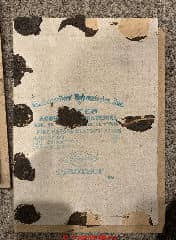 Was there Asbestos in Simpson Ceiling Tiles?
Was there Asbestos in Simpson Ceiling Tiles?
2019-02/20 Jessica C said:
Wondering if you have any info on
UnderwritersLlaboratories Inc UL-
Listed
Acoustical material
Code 85 issue no. Af-646
Simpson Pyrotect
[Click to enlarge any image] - shown above, back imprint information on Simpson Pyrotect ceiling tiles. At page top: Simpson Forestone ceiling tiles.
On 2019-02-20 by (mod) - asbestos content in Simpson Pyrotect
Jessica, please see your question and a detailed reply found
Do our 1947- vintage Simpson ceiling tiles contain asbestos?
We wanted to replace the old ceiling tiles with drywal & ripped a couple down to see what we were working with.. the home was built in 1947. Any idea a date for these or if they contain asbestos? On 2018-06-17 by katie.nussbaum16
Reply by (mod) -
Katie
Please see SIMPSON CEILING TILES
where we will add your photo to invite further comment. There a reader reports that Simpson (your ceiling tile is a Simpson Fonestone) informed him that their Fonestone line of ceiling tiles does not contain asbestos.
Case law raises some question and adds confusion to the asbestos question for Simpson Fonestone.
Let us know if you have further questions.
Was there Asbestos in Conwed Ceiling Tiles?
I have a t-bar drop ceiling I would like to take down and I'm wondering about asbestos in the ceiling panels. I found an old box-looks like they were made by the Conwed Corporation, St Paul Minnesota.
Product name is Nu-Wood Travertine Ceiling Panels 1/2 x 24 x 48. There is a big 368 on the label, and a small LA-368 followed by 11-72 which might be a date code. It also says "Approved by the Board of Standards and Appeals for use in New York City, under calendar No. 996-38-SM. Thanks - 2017-06-07 by Dan
Reply by (mod) - Asbestos in Conwed Ceiling Tiles
Dan,
Conwed (LoTone) did use asbestos in at least some ceiling tile products.
Here is an example case
"Jury Awards $4.5M to Family in Asbestos Case" [web page] www.law360.com/articles/105130/jury-awards-4-5m-to-family-in-asbestos-case
Other law firm websites also assert that some Conwed ceiling tiles contained asbestos:
www.lipsitzponterio.com/jobsites-occupations-Ceiling_Tile_Asbestos_Mesothelioma.html
Watch out: The case citation comments that it can be very difficult to tell the products apart.See details at SIMPSON CEILING TILES - you are on this page
and also at SIMPSON FIBERBOARD ASBESTOS?
Also see IDENTIFY NU-WOOD PANELS
Also see FIBERBOARD PANEL REPAIR
Question: asbestos in Simpson Timber Co. of Seattle "Dectile Class III Vinyl coated decorative tiles"
15 June 2015 Ron W. said:
My mom just passed away and her house has the Simpson Timber Co. of Seattle "Dectile Class III Vinyl coated decorative tiles" in it.
We are selling the house and a potential buyer asked about the possibility of them containing asbestos. Do you know if this particular type did?
Reply:
Ron
Please see details at SIMPSON CEILING TILES
Reader question: Did 2x4 foot ceiling tiles from an old store contain asbestos?
back in 1996, A friend of mine picked up a truck load of 2x4' ceiling tiles that were being removed from a small grocery store for total renovation (new owners I believe).
Anyway we finished his basement over several days, and never even thought that they could be asbestos containing.
Unfortunately, there is no way for me to test as he no longer lives in that house. They look like your common "department store/hospital" 2x4 tile, fairly heavy, could be broken easily (crumble), grey/brown back color with white face, and they did not burn (we tried!!) They almost seemed to be made of plaster or clay if I remember correctly.
As this was 1996, Its likely the tiles were at least 10-20 years old, which is worrying to me. I found a picture of the room where they were installed, not very clear as it was taken 10 years ago, but I could send it if you like.
They had a design texture very similar to this: i.imgur.com/m0wS9h6.jpg
Follow up picture to previous comment, this is the only known picture i was able to find of the tiles in question. I wish I could do better. imgur.com/NpnfGtQ (Mar 6, 2014) Mike
Reply:
Mike we can't say from just the acoustic ceiling tile pattern if the product contained asbestos or not; and indeed even some older ceiling tiles have been tested and found not to contain asbestos.
If the second photo link you sent was of the room you describe I can't add a thing other than that we're apparently looking at a suspended ceiling from 2004 (10 years ago) or older.
Reader follow-up:
Thank you for the reply. Yes, 10 year old picture of a 20 year old renovation, I wish I would have taken some close up pictures when I had the chance. The tiles most certainly were made sometime during the 1970's or 80's.
Was it common for this style drop ceiling tiles in commercial settings to contain asbestos during that time?
Reply:
Ah - so if we're talking about ceiling tiles from the 1970's or early 80's asbestos was a possibility - but did not appear in all brands and products of ceiling tiles
...
Continue reading at ASBESTOS CEILING TILE REMOVAL PROCEDURES or select a topic from the closely-related articles below, or see the complete ARTICLE INDEX.
Or see these
Recommended Articles
- ASBESTOS CEILING TILE IDENTIFICATION
- ASBESTOS-FREE CEILING TILES
- CEILING TILE HISTORY / DATES - asbestos ceiling tile history & Dates
- ASBESTOS CEILING TILE IDENTIFICATION - 5 Easy Steps to tell if CEILING TILES are likely to contain asbestos -
- ARMSTRONG CEILING TILES
- ARMSTRONG MINATONE CEILING TILES
- BOISE CASCADE CEILING TILES
- CARILLON CEILING TILES
- CELOTEX CEILING TILES
- CELOTEX ASBESTOS PRODUCTS
- CELOTEX CemestO BOARD HOMES
- CONWED CEILING TILES
- DOMTAR CEILING TILES
- FRF CEILING TILES
- HOMART CEILING TILES
- JOHNS MANVILLE CEILING & WALL PANELS
- MALAYSIAN CEILING TILES
- NATIONAL GYPSUM CEILING TILES
- NU-WOOD STA-Lite CEILING TILES
- OWA CEILING TILES
- PINEX CEILING TILES
- SEARS ROEBUCK CEILING TILES
- SHERES CEILING TILES
- SIMPSON CEILING TILES
- US GYPSUM CEILING TILES
- CEILING TILE INGREDIENTS
- CEILING TILE REMOVAL PROCEDURES
- CEILINGS, DROP or SUSPENDED PANEL
- ASBESTOS CEILING TILE IDENTIFICATION - 5 Easy Steps to tell if CEILING TILES are likely to contain asbestos
- ASBESTOS CEILING TILE ID REQUESTS
- ASBESTOS CEILING TILE REMOVAL PROCEDURES
- ASBESTOS-FREE CEILING TILES
- ASBESTOS-SUSPECT CEILING COVEROVER
- ASBESTOS TESTING LAB LIST - certified asbestos testing labs
- SIMPSON FIBERBOARD ASBESTOS?
Suggested citation for this web page
SIMPSON CEILING TILES at InspectApedia.com - online encyclopedia of building & environmental inspection, testing, diagnosis, repair, & problem prevention advice.
Or see this
INDEX to RELATED ARTICLES: ARTICLE INDEX to ASBESTOS HAZARDS
Or use the SEARCH BOX found below to Ask a Question or Search InspectApedia
Ask a Question or Search InspectApedia
Try the search box just below, or if you prefer, post a question or comment in the Comments box below and we will respond promptly.
Search the InspectApedia website
Note: appearance of your Comment below may be delayed: if your comment contains an image, photograph, web link, or text that looks to the software as if it might be a web link, your posting will appear after it has been approved by a moderator. Apologies for the delay.
Only one image can be added per comment but you can post as many comments, and therefore images, as you like.
You will not receive a notification when a response to your question has been posted.
Please bookmark this page to make it easy for you to check back for our response.
IF above you see "Comment Form is loading comments..." then COMMENT BOX - countable.ca / bawkbox.com IS NOT WORKING.
In any case you are welcome to send an email directly to us at InspectApedia.com at editor@inspectApedia.com
We'll reply to you directly. Please help us help you by noting, in your email, the URL of the InspectApedia page where you wanted to comment.
Citations & References
In addition to any citations in the article above, a full list is available on request.
- [18] U.S. Environmental Protection Agency (USEPA—Green Book) (1990). In Managing Asbestos in Place: A Building Owners Guide to Operations and Maintenance Programs for Asbestos-Containing
- EPA Guidance for Controlling Asbestos-Containing Materials in buildings, NIAST, National Institute on Abatement Sciences & Technology, [republishing EPA public documents] 1985 ed., Exposure Evaluation Division, Office of Toxic Substances, Office of Pesticides and Toxic Substances, U.S. Environmental Protection Agency, Washington,D.C. 20460
- In addition to citations & references found in this article, see the research citations given at the end of the related articles found at our suggested
CONTINUE READING or RECOMMENDED ARTICLES.
- Carson, Dunlop & Associates Ltd., 120 Carlton Street Suite 407, Toronto ON M5A 4K2. Tel: (416) 964-9415 1-800-268-7070 Email: info@carsondunlop.com. Alan Carson is a past president of ASHI, the American Society of Home Inspectors.
Thanks to Alan Carson and Bob Dunlop, for permission for InspectAPedia to use text excerpts from The HOME REFERENCE BOOK - the Encyclopedia of Homes and to use illustrations from The ILLUSTRATED HOME .
Carson Dunlop Associates provides extensive home inspection education and report writing material. In gratitude we provide links to tsome Carson Dunlop Associates products and services.


